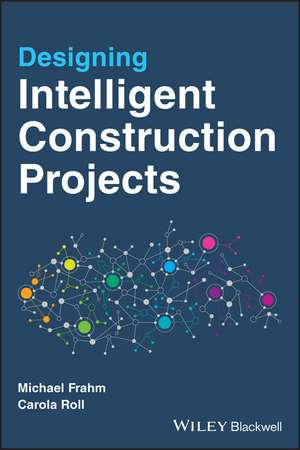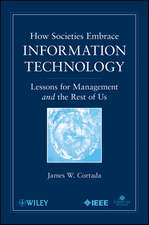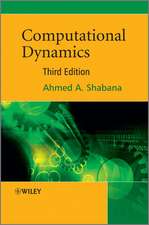Designing Intelligent Construction Projects
Autor M Frahmen Limba Engleză Paperback – 31 aug 2022
Preț: 371.91 lei
Preț vechi: 464.89 lei
-20% Nou
Puncte Express: 558
Preț estimativ în valută:
71.16€ • 77.54$ • 59.97£
71.16€ • 77.54$ • 59.97£
Carte disponibilă
Livrare economică 02-16 aprilie
Livrare express 19-25 martie pentru 26.14 lei
Preluare comenzi: 021 569.72.76
Specificații
ISBN-13: 9781119690825
ISBN-10: 111969082X
Pagini: 256
Dimensiuni: 153 x 230 x 15 mm
Greutate: 0.34 kg
Editura: Wiley
Locul publicării:Chichester, United Kingdom
ISBN-10: 111969082X
Pagini: 256
Dimensiuni: 153 x 230 x 15 mm
Greutate: 0.34 kg
Editura: Wiley
Locul publicării:Chichester, United Kingdom
Cuprins
Preface xi
Acknowledgements xv
About the Authors xvii
1 Complexity, Cybernetics, and Dynamics 1
1.1 Complexity 2
1.1.1 Complexity in the Mathematical Sciences 2
1.1.2 Complexity in Sociology 3
1.1.3 Complexity in Management 3
1.1.4 Complexity in Construction Management 6
1.1.5 How to Cope with Complexity 7
1.1.6 Interaction and Autopoiesis 9
1.2 Viable System Model 10
1.2.1 The Static Perspective on the VSM 11
1.2.1.1 System 1: Operation 14
1.2.1.2 System 2: Coordination 14
1.2.1.3 System 3: Operational Management 14
1.2.1.4 System 3*: Monitoring/Audit 15
1.2.1.5 System 4: Strategic Management 15
1.2.1.6 System 5: Policy 15
1.2.2 Ashby's Variety 16
1.2.2.1 The Variety Number 18
1.2.2.2 The Degree of Variety 18
1.2.3 The Dynamic Perspective on the VSM 23
1.2.3.1 Variety Balance 1: Workload 26
1.2.3.2 Variety Balance 2: Line Balancing 26
1.2.3.3 Variety Balance 3: Autonomy vs. Cohesion 26
1.2.3.4 Variety Balance 4: Change Rate 27
1.2.3.5 Variety Balance 5: Change vs. Status Quo 27
1.3 Modelling with the Viable System Model 28
1.3.1 Modelling Steps 28
1.3.2 Create a VSM Model Using an Example 29
1.4 System Dynamics 34
1.4.1 Systemic Archetypes 34
1.4.2 Modelling with System Dynamics 43
1.4.3 Example: Managing Risks with System Dynamics 43
1.5 Findings, Criticism, and Reflective Questions 44
1.5.1 Findings 44
1.5.2 Criticism 45
1.5.3 Reflective Questions 46
2 Lean Management and Lean Construction 47
2.1 Pioneers of Lean Management 48
2.2 Toyota Production System and Tools 49
2.2.1 Waste, Kanban, and Just-in-time Principle 51
2.2.2 Jidoka and Related Elements 54
2.2.3 Heijunka 58
2.2.4 Single Minute Exchange of Die (SMED) 60
2.2.5 Kaizen and Standards 60
2.3 Lean Management and Its Principles 61
2.3.1 Resource and Flow Efficiency 63
2.3.2 Examples for Resource and Flow Efficiency 64
2.3.2.1 The Machine and Plant Manufacturer 64
2.3.2.2 The Vacation Flight 65
2.3.2.3 The Healthcare System 65
2.3.2.4 The Automotive Industry 65
2.3.3 Four Important Principles 65
2.3.3.1 Flow Principle 66
2.3.3.2 Takt Principle 66
2.3.3.3 Pull Principle 66
2.3.3.4 Zero-defect Principle 66
2.3.4 Lean Leadership 66
2.3.4.1 Excursion: Kata 67
2.4 Lean Construction and Tools 70
2.4.1 Last Planner System 72
2.4.1.1 Milestone Planning 74
2.4.1.2 Collaborative Programming 74
2.4.1.3 Making Ready 74
2.4.1.4 Production Planning 74
2.4.1.5 Production Management and Learning 74
2.4.2 Takt Planning and Control 76
2.4.2.1 Takt Planning 77
2.4.2.2 Takt Control 78
2.4.3 Last Planner System and Takt Planning and Control 78
2.4.4 Lean Construction Case Study 80
2.4.4.1 Takt Planning 81
2.4.4.2 Takt Control 85
2.5 Tools, Tools, Tools 87
2.5.1 First-run Study 88
2.5.1.1 Phase Plan 88
2.5.1.2 Phase Do 88
2.5.1.3 Phase Study 89
2.5.1.4 Phase Adjust 89
2.5.2 Waste Walks 89
2.5.2.1 5 Why and 6W Questioning Technique 90
2.5.3 Ishikawa Diagram 91
2.5.4 A3 Method and Report 92
2.5.5 Visual Management 94
2.5.6 5s/5a 96
2.5.6.1 Seiri - Sort 96
2.5.6.2 Seiton - Set in Order 96
2.5.6.3 Seiso - Shine 97
2.5.6.4 Seiketsu - Standardise 97
2.5.6.5 Shitsuke - Sustain 97
2.5.7 Plus/Delta Review 97
2.5.8 Big Room 99
2.6 Practice Insights from Martin Jäntschke 101
2.6.1 Infrastructure Railway - Introduction of Lean Construction in Large Projects 101
2.6.2 Implementing Change in an Infrastructure Organisation 104
2.6.3 Conclusion 108
2.6.3.1 To Section 2.6.1 108
2.6.3.2 To Section 2.6.2 109
2.7 Findings, Criticism, and Reflective Questions 109
2.7.1 Findings 109
2.7.2 Criticism 110
2.7.3 Reflective Questions 112
3 Cybernetics and Lean 113
3.1 VSM and Lean (Construction) Thinking 115
3.2 Mapping the Viable System Model with Lean Construction Methods 116
3.2.1 Mapping VSM and the Last Planner System 117
3.2.2 Mapping VSM and Takt Planning and Control 118
3.2.3 Mapping Information Channels and Lean Construction 118
3.3 Mapping the Viable System Model with Lean Management Methods 119
3.4 Performance Measurement 124
3.4.1 General Measurement 124
3.4.2 Lean Measurement Construction 126
3.4.3 Beers' Triple 126
3.5 Case Studies and Practice Insights 128
3.5.1 Case Study: Planning Project 128
3.5.2 Case Study: Major Project (Planning and Execution) 130
3.5.2.1 Design Phase and Approval Phase 131
3.5.2.2 Tendering and Awarding Phase 132
3.5.2.3 Construction Phase 133
3.5.3 Case Study: Megaproject (Execution) 134
3.5.3.1 Boundary Conditions 134
3.5.3.2 Analysis of the Megaproject 140
3.5.3.3 Section Analysis 140
3.5.4 Practice Insights from a Medium-sized Mechanical Engineering Company 143
3.5.4.1 Challenges for the Industry 143
3.5.4.2 The Solution: The Creation of a Hybrid Corporate Form Based on the Vsm 144
3.5.4.3 From Theory to Practice: The Organisational Structure 146
3.5.4.4 Levels of Complexity 147
3.5.4.5 Process Organisation 149
3.5.4.6 Role Profiles 154
3.5.4.7 Organiplastic as a Base for the Management Cockpit 154
3.5.4.8 Conclusion 157
3.5.4.9 Adaptability 159
3.6 Findings, Criticism, and Reflective Questions 159
3.6.1 Findings 159
3.6.2 Criticism 161
3.6.3 Critical Reflection to Practice Insights from a Medium-sized Mechanical Engineering Company 161
3.6.4 Reflective Questions 162
4 Beyond Cybernetics and Lean 163
4.1 Control, Regulate, Steer 164
4.2 Self-organisation 165
4.3 Viable, Lean, ... and What About Agile? 166
4.4 Digital Transformation 167
4.5 Phases of Digital Change 169
4.6 Digitalisation in the Construction Industry 170
4.6.1 Status Quo 171
4.6.2 Phase 1: BIM, VR, AR, MR 172
4.6.3 Phase 2: Intelligent Project Management 174
4.6.4 Phase 3: Artificial Intelligence in Construction 176
4.6.5 Phase 4: Autonomous Project Management 179
4.7 Changing the Game 180
4.7.1 Nudge Management 180
4.7.2 Tit for Tat 181
4.8 Partnering 183
4.9 Success Patterns in Projects 186
4.10 Findings, Criticism, and Reflective Questions 190
4.10.1 Findings 190
4.10.2 Criticism 191
4.10.3 Reflective Questions 193
5 Summary and Closing Remarks 195
5.1 Complexity, Cybernetics, and Dynamics 196
5.2 Lean Management and Lean Construction 196
5.3 Cybernetic and Lean 197
5.4 Beyond Cybernetic and Lean 197
References 199
Glossary 209
List of Figures 215
List of Tables 219
List of Equations 221
List of Abbreviations 223
Index 227
Notă biografică
Michael Frahm was educated in Stuttgart, Kaiserlautern, and Saarbrücken in engineering and business law, and has fifteen years of professional experience in mega construction project management. He is director of the non-profit association for Systems and Complexity in Organisation (SCiO) for Germany and is a Certified Advanced System Practitioner of this organization. Carola Roll was educated in Straubing and Krems in technical business administration, lean operations management, and integrated management systems and has over 20 years of professional experience in interface positions between business administration and technology in various medium-sized companies. She is director of the non-profit association for System and Complexity in Organisation (SCIO) for Germany and head of Bavaria's related practice group.











